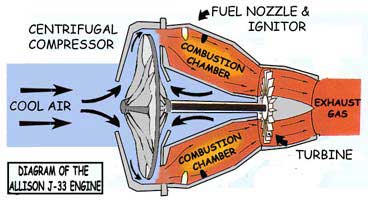How many of us know why a jet engine moves through the air?
cheers
Seeing that you were being serious I'll answer your question as best I can.
If you think about a 2 stroke engine it has 2 strokes of the piston for a cycle. Basically these are compression and exhaust (I'll ignore how the mixture gets into the barrel for this explanation). A jet engine is similar. The air is sucked in at the front and compressed, the fuel is then burned and it is exhausted out the back:
A big difference is that the fuel is burned continuously and not in cycles.
After the fuel is burned at expands rapidly causing the turbine at the back to rotate which drives the compressor...

When Whittle first conceived the jet engine he realized that, with a turbo charged piston engine, you didn't really need the piston engine and that it could be replaced with just a combustion chamber and, if you look at his design (called a centrifugal jet) you'll see that's exactly what it is:

Look familiar?